#Trabant P 50
Photo
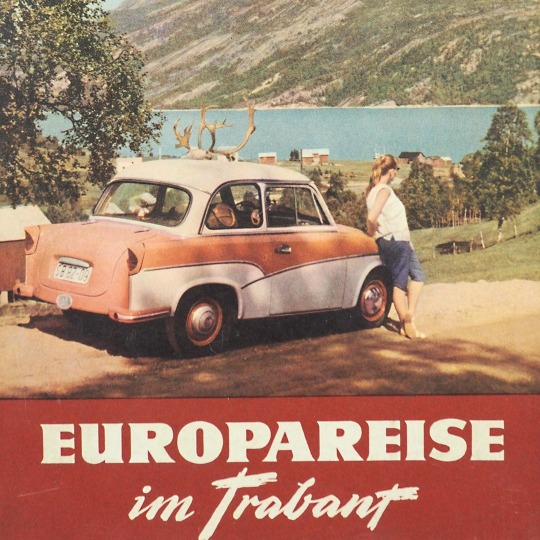
Heute vor 65 Jahren rollte der erste Trabant P 50 im VEB Automobilwerke Zwickau vom Band. Wir zeigen euch ein Buchcover des Titels »Europareise im Trabant« (1962) aus unserer Sammlung. On this day 65 years ago, the first Trabant P 50 rolled off the production line at VEB Automobilwerke Zwickau. We show you a book cover of the title »Trip through Europe in the Trabant« (1962) from our collection. #ddrmuseum #ddr #gdr #museum #museumberlin #trabant #zwickau #p50 #trabi #ddrgeschichte — view on Instagram https://ift.tt/RTnjNOp
34 notes
·
View notes
Text

Kugelporsche Tempera / Aquarell
Aquapril 2021
#original my work#my work#my artwork#Kugelporsche#trabant#trabant car#Trabant P 50#aquapril#aquapril challenge#challenge#aquapril 21#aquarelle#watercolourpainting#watercolour art#waterchallenge#watercolour illustration#illustrator#illustration#watercolor#tempera painting#tempera#comicart#comic style#my art#art#artwork#drawing#artist#blog#art blogger
2 notes
·
View notes
Photo

Trabant 600 war die Verkaufsbezeichnung der zweiten Version des Trabant. Der PKW mit der internen Typenbezeichnung P60 wurde 1962 bis 1964, Kombi und Lieferwagen bis 1965, im VEB Sachsenring Automobilwerk in Zwickau gebaut, der Motor wurde im Barkas-Werk produziert. Erhältlich war der Zweitürer als Limousine und Kombi-Version mit großer Heckklappe sowie als Lieferwagen und als sogenannter Kombi Camping mit Liegesitzen und Faltschiebedach. . Der P60 war der Nachfolger des Trabant P50. Es gab nur kleinere Änderungen, wesentlich war die Leistungssteigerung. So leistete der Zweizylinder-2-Takt-Motor mit den nunmehr 599 cm³ im 600er 23 PS (16,92 kW). Die Duroplast-Karosserie auf Stahlskelett blieb unverändert, so ist der Trabant 600 äußerlich fast nur durch die 600 am Heck von seinem Vorgänger zu unterscheiden. . Neben der Standard-Limousine gab es als „Sonderwunsch“ Zierleisten, eine Sonnenblende, die außen auf die Frontscheibe aufgesetzt wurde, sowie Chromteile an den Stoßstangen. Erhältlich war wie schon beim Vorgängertyp eine Kombi-Version mit seitlich öffnender Heckklappe, sowie ein sogenannter Kombi Camping mit Liegesitzen und Faltschiebedach. In geringem Umfang wurde auch ein Lieferwagen-Variante produziert. Optional konnte eine Anhängevorrichtung für Anhängelasten bis 200 kg erworben werden. Ebenso war – genauso wie beim Kombi – ein Dachgepäckträger (50 kg Dachlast) optional erhältlich. Im Volksmund trug der Trabant 600 unter anderem wegen seines runden Designs den Spitznamen „Kugelporsche“. . Der Neupreis für den Trabant erhöhte sich mit Einführung des 600 cm3 Motors um 200 DM. Somit kostete die Standardausführung nun 7850 DM und die Sonderausführung 8840 DM.(#Wikipedia) #Farben #Farbkarte #Trabant #Trabant600 #TrabantCamping #Kombi #Car #Color #VEB #Sachsenring #Automobilwerke #Zwickau #DDR #GDR #Reklame #Ostalgie #EastGermany (hier: Zwickau, Germany) https://www.instagram.com/p/CEqZU9Op_MN/?igshid=aj5m9cfm3cyb
#wikipedia#farben#farbkarte#trabant#trabant600#trabantcamping#kombi#car#color#veb#sachsenring#automobilwerke#zwickau#ddr#gdr#reklame#ostalgie#eastgermany
5 notes
·
View notes
Photo

EDICIÓN DE 30 ANIVERSARIO VINILO DISPONIBLE EL 19 DE NOVIEMBRE BOXSET DIGITAL DISPONIBLE EL 3 DE DICIEMBRE Island Records, Interscope y UMe anuncian el lanzamiento de la Edición del 30 aniversario del álbum seminal de U2, Achtung Baby, que verá un lanzamiento especial en vinilo estándar y de lujo el 19 de noviembre, además de una caja digital de 50 tracks disponible el 3 de diciembre de 2021. Hace treinta años, Bono describió a Achtung Baby como "el sonido de cuatro hombres talando el árbol de Joshua", mientras que Jon Pareles del New York Times escribió que "despojado y desafiando sus viejas fórmulas, U2 se ha dado una oportunidad de luchar por la 1990's ”. El álbum ganó un premio Grammy a la Mejor Interpretación de Rock y se convirtió en uno de los discos más importantes de los noventa y de la carrera de U2. Grabado durante seis meses en Hansa Studio en Berlín y Windmill Lane en Dublín, Achtung Baby es el séptimo álbum de estudio de U2. Producido por muchos colaboradores de U2, Daniel Lanois y Brian Eno con Steve Lillywhite, Achtung Baby fue diseñado por Flood y lanzado el 18 de noviembre de 1991. Liderado por The Fly, le siguieron otros cuatro sencillos: Mysterious Ways, One, Even Better Than The Real Thing and Who’s Gonna Ride Your Wild Horses. Míralo aquí. Para celebrar el aniversario de Achtung Baby, la banda colaboró con el artista francés con sede en Berlín Thierry Noir (el primer artista en pintar en el Muro de Berlín) para una instalación única en los legendarios estudios Hansa en Kreuzberg. Hace treinta años, la banda encargó a Noir que pintara una serie de los ahora icónicos Trabant Cars, que aparecían en la portada del álbum, así como en el Zoo TV Tour de 1991. U2 x THIERRY NOIR ve a Noir regresar con un Trabant recién pintado para 2021, así como un mural pintado exclusivo en una sección del muro de Berlín El capó del Trabant se subastará en Phillips, Londres, el 9 de diciembre como parte de su venta New Now y los ingresos se destinarán al Instituto de Sonido y Música de Berlín. Para obtener más información, visite: https://www.phillips.com/auctions/auction/UK010821 Achtung Baby (30th Anniversary Edition) https://www.instagram.com/p/CWZVnkcMypb/?utm_medium=tumblr
0 notes
Text
Ce sont vos meilleures histoires de déchirure avec vos parents
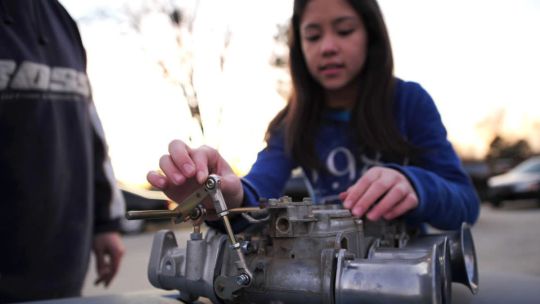
Max Finkel dimanche 17:05 • p Réponses du week-end 13.6K 42 Enregistrer Image: U.S.Air Force. Je suis heureux que ma question d'hier sur le travail avec vos parents vous ait rappelé tant de souvenirs. Je pose au moins une question chaque week-end et je suis toujours ravi de lire les réponses, mais cette semaine a été très spéciale. Voici quelques un de mes préférés. Je n'ai jamais réussi à convaincre mes parents de faire des choix délirants avec leurs voitures (même si mon père prétendra que mon influence a été un facteur important dans son Audi A8 d'occasion malheureuse). Notre ami ici aurait peut-être eu plus de chance de réussir à obtenir ces tuyaux sur la vieille panthère de sa mère. Marche à suivre. Cela me fait plaisir d'entendre cette histoire sur une équipe père-fille qui se lie pour garder sa Mini en marche. J'espère que je pourrai aussi impliquer mes enfants une fois que j'en aurai. Je suis honnêtement très impressionné que ce duo ait réussi à rester sain d’esprit tout en travaillant sur une voiture britannique des années 50. Peut-être que les histoires de toutes les aventures qui ont précédé la refonte étaient suffisantes pour garder la lumière même au milieu de tout ce travail de câblage. Tout comme l'Austin Healey ci-dessus, c'est l'ingénierie anglaise qui a réuni cette équipe père-fils. Je ne m'inquiète pas de ma relation avec mon père, mais si je l'étais, je pense que faire quelque chose de vieux et de britannique serait exactement ce dont nous aurions besoin pour régler quoi que ce soit. Si la voiture roule à la fin, ce serait juste un bonus. Il est toujours agréable d'entendre les commentaires estimés de ce blog. J'adore quand je peux poser une question qui fait ressortir des souvenirs, des opinions ou simplement une émotion brute en chacun de vous. Merci à tous et continuez. Max Finkel publie sur Twitter Max Finkel est un contributeur de week-end chez Jalopnik. Partagez cette histoire h4 Abonnez-vous Plus de Jalopnik Il est temps d'en apprendre davantage sur le mystère de la folle voiture record de vitesse au sol de type locomotive de 1932 J'ai essayé de réparer la Mini Cooper S de mon ami, mais j'ai foiré et maintenant la voiture est bloquée Trabant Factory est hilarant dans la façon dont vous pensez que c'est F1 devrait se débarrasser de ses camping-cars de luxe dès que possible si elle veut être neutre en carbone Partager Tweet
0 notes
Photo

1958 AWZ P 70 Coupé at the August Horch Museum in Zwickau. About 1500 units were built 1957–1959 by the VEB Automobilwerk Zwickau (AWZ). The P 70s successor was the Trabant P 50. [Ad/Werbung, tagging unpaid/unbezahlt] #AWZP70 #AWZP70Coupe #AutomobilwerkZwickau #gdrcar #ostfahrzeuge #ddrfahrzeuge #ddrauto #eastgermancar #germancar #germancars #classicsdaily #carspotting #carspotter #classiccarspotting #teilixawz #vintagecar #classiccar #classiccars #oldtimer #retrocar #CarPhotography #classiccaroftheday #carworld #rarecar #automotivephotography #AugustHorchMuseum #carmuseum #AutoMuseum (hier: August Horch Museum Zwickau gGmbH) https://www.instagram.com/p/B75bEonIZ1D/?igshid=6cqytjmwrtp8
#awzp70#awzp70coupe#automobilwerkzwickau#gdrcar#ostfahrzeuge#ddrfahrzeuge#ddrauto#eastgermancar#germancar#germancars#classicsdaily#carspotting#carspotter#classiccarspotting#teilixawz#vintagecar#classiccar#classiccars#oldtimer#retrocar#carphotography#classiccaroftheday#carworld#rarecar#automotivephotography#augusthorchmuseum#carmuseum#automuseum
0 notes
Text
New top story from Time: East Germans Were Welcomed to the West with Free Money. Here’s What They Bought After the Berlin Wall Fell
Peter Keup can still remember how it felt to hold deutsche marks in his hand.
“It was special to even touch this money,” he recalls. “It felt solid. The East German mark was thinner, flimsier.” As a boy growing up in East Germany, he was sometimes sent West German currency by his grandparents on the other side of the border, be it as a birthday gift or a reward for good school grades. Keup pored obsessively over the notes, minted with the mysterious–sounding titles and images of unknown cities and historical figures. “Names from behind the Iron Curtain, an invisible world,” he reflects. Their worth to him was far more than simply financial.
In any case, there was only so much the 16 million citizens of the communist German Democratic Republic (G.D.R.) could buy in a sealed-off country of scarcity, shortages and joyless austerity. Tantalizing tastes of Western consumer goods could be obtained on the black market and at state-run “Intershops,” which only accepted hard currency, like dollars or deutsche marks. Cigarettes, coffee, chocolate and pop records were on offer to those who could afford them. Others had to find their pleasures where they could. “I loved the smell of Persil and Ariel detergent in the clothes,” reminisces Nicole Hartmann, of receiving packages of hand-me-downs from relatives in the West as a young girl. “I always wanted to keep them unwashed.”
When the Berlin Wall fell in November 1989, followed by the inner German border that ran from Czechoslovakia to the Baltic Sea, the gates to the West were opened to all, and the bounties and temptations that lay beyond. By foot and by row upon row of Trabant and Wartburg cars, the “Ossis” (as East Germans were known) began to pour across what had been one of the most secure borders in the world. Were that not all reason enough to feel euphoric, there was more awaiting them on the other side: free money.
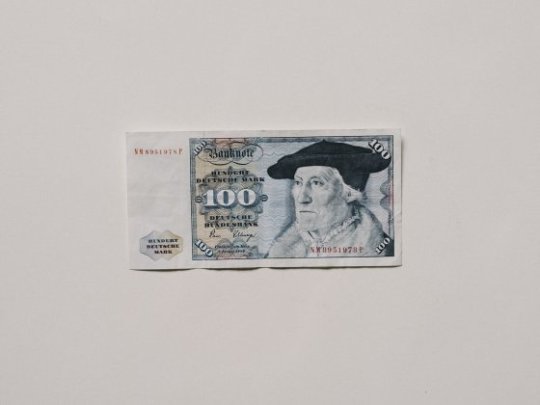
Nanna Heitmann—Magnum Photos for TIMEA 100 Deutsche Mark bill.
Since 1970, East Germans arriving to the Federal Republic of Germany by whatever means were paid a grant, initially of 30 deutsche marks (DM) twice a year, later rising to 100 DM once a year, under a program known as Begrüßungsgeld or “welcome money.” Under Chancellor Willy Brandt’s Ostpolitik policy of peaceful rapprochement, the measure was intended to help the few people who did manage to depart the G.D.R., legally or otherwise, to pay for food or travel. The amount is equivalent to about $100 in today’s money.
After the abrupt and entirely unforeseen rupture of the Berlin Wall, demand for welcome money surged—and the West German authorities stuck to their promise. As word spread like wildfire among arriving Ossis, long queues began to form outside banks and building societies. The state-sanctioned handout triggered a colossal spending spree across Berlin’s River Spree. It was a commercial revolution, and a moment of mass transactional transference from socialism into capitalism and the material world. Considered a gift by some and a bribe by others, it helped set the tone for full and swift reunification by October 1990, firmly on West German terms.
No official statistics exist as to exactly how much was claimed in all, but by the time payments were halted on Dec. 29, 1989, replaced by a foreign currency fund that both German states contributed to, it’s estimated that at least 4 billion DM had been paid out in a matter of just seven weeks. “I think over 95% [of East Germans] got this money,” speculates Sören Marotz, historian at the DDR Museum of East Germany’s history. “Some people found ways to claim the money more than once.”
On West Berlin’s glittering technicolor shopping boulevard, the Kurfürstendamm, the famous KaDeWe department store was a first port of call for many—to spend or simply to stare in awe at its luxurious abundance. In supermarkets in the borderlands of West Germany, witnesses remember seeing shelves stripped bare. Almost everyone claimed their 100 DM, from the current Chancellor Angela Merkel, then a 35-year-old physicist living in East Berlin, to sports stars, doctors, artists, political dissidents, musicians, families, pensioners and Stasi agents. Even babies were eligible for a payout.
Cash injections to the former G.D.R. have in some ways never ceased. Since 1991, Germans have paid a so-called solidarity surcharge, a fee on income, capital gains and corporate taxes currently set at 5.5%, in order to help the former communist east. Yet despite receiving €243 billion in “Soli” taxes since 1995, the economy in the country’s East continues to lag far behind the West’s. Unemployment is higher, wages are lower, and the population of the former G.D.R.’s territory has dropped to its lowest level in 114 years. It has given rise among some to what is known as “Ostalgia,” a longing for the simplicity and cradle-to-grave comforts of life in the G.D.R. Political disaffection has seen parts of the former East become a heartland for populist parties; in the eastern state of Thuringia on Oct. 27, the far-right anti–migrant Alternative for Germany party finished ahead of Merkel’s -center-right party in local elections.
What East Germans decided to buy when the Wall fell says a lot about that moment in our history, 30 years ago—about the true value of money, about competing economic systems, and about the hopes, freedoms and tensions of reunifying a country. Each purchase tells its own story. Here are 10 of them:
The All-American Doll
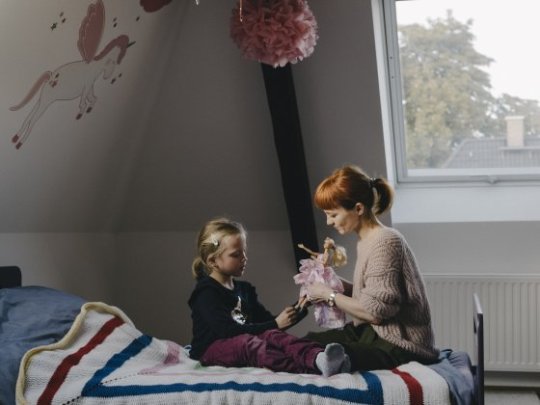
Nanna Heitmann—Magnum Photos for TIMESusan Penquitt and her daughter Nora play with the Barbie she bought in 1989.
“There was a long row of cars in the middle of the night,” Susan Penquitt remembers vividly, despite being just 8 years old when her family drove across the border into West Germany for the first time. The road led to the city of Fulda in Hesse, about 65 miles east of Frankfurt, and the toy section of a department store, a sight the little girl had barely dreamed of. “When I saw the Barbie on the shelf, you know, that was it. I don’t remember any other toy in that shop.”Lovingly looked after for three decades, the iconic American doll today belongs to Penquitt’s eldest daughter Nora, 8, in their home outside of Leipzig. It’s a happy token of what was not always a happy time. Like millions of East Germans working in largely state-owned industries, both of Penquitt’s parents lost their jobs following reunification. “They never had so many sorrows really,” she says.
A Grand Scheme for a Piano
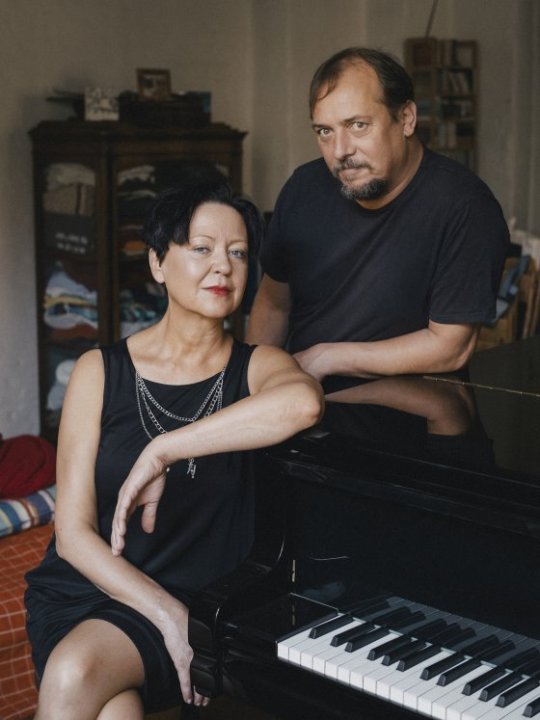
Nanna Heitmann—Magnum Photos for TIMEElse Gabriel, left, and Ulf Wrede with their Bösendorfer piano.
The bohemian East Berlin performance artists Else Gabriel and Ulf Wrede celebrated their first days and nights in the West like many Germans did: together in a beer-soaked haze. “We gave pieces of the Wall to people in bars and they gave us drinks,” 57-year-old Gabriel recalls. “Everyone was so out of control. It felt like you could do anything, there was two systems just collapsing into each other.” By ripping out pages from their passports to remove collection stamps, they say they claimed their Begrüßungsgeld multiple times between them. “I spent 27 years of my life in f-cking East Germany,” Gabriel says. “There was no guilt about [taking] a few hundred deutsche marks.”
Gabriel had been permitted to leave the G.D.R. just days before the Wall fell, and had earned some deutsche marks there already. The couple combined their funds left over after the revelries and changed it all back to Eastern currency, taking advantage of a black market exchange rate to convert around 2,000 DM into around 10,000 Eastern marks. After smuggling it back into East Germany in Wrede’s socks (“It stank when we pulled the money out,” Gabriel laughs), the pair used their haul to pay off a loan on a Bösendorfer grand piano. In his Neukölln studio apartment today, Wrede, 51, still plays the dusty black keyboard, now worth many times the price he paid for it 30 years ago. “Best deal ever,” Gabriel grins proudly.
Black Adidas, White Stripes
At the time the Wall fell, Andreas Thom was already living a privileged life. At 24, he had played 51 matches for the East German national soccer team, and won the G.D.R. Premier League five times with Dynamo Berlin. Surely Thom had no need for his Begrüßungsgeld? “Of course I got the money,” he says. “Everybody got the money!” On a shopping trip to the KaDeWe, he purchased a pair of soccer shoes: “Adidas Samba Spezial, black with white stripes.” Just 37 days after reunification, Thom made history as the first East German player to sign for a West German club, when he moved to Bayern Leverkusen for a fee of 2.5 million DM. He thinks back to his debut game in February 1990 vs. FC Homburg. “Everybody was watching [as if] I had four arms, two heads, four legs,” he says. “But I scored, and everything was O.K.”
An Exotic Feast of Rare Foods
A dissident photographer, Harald Hauswald’s evocative black-and-white street scenes from behind the Wall were published in West German magazines as well as in a controversial book, making him a person of interest to the hated state security police. Hauswald escaped serious imprisonment only because of his connections to influential Western journalists, who would help him smuggle his film reels out. Shooting sometimes literally from the hip, he wielded his camera like a weapon. “I felt so trapped by the Wall,” says the 65-year-old. “Taking photographs was the work I did to fight against that feeling.” Hauswald and his friends bought a victory feast of foods unavailable in the East with their welcome money. “Kiwi and radicchio, that kind of stuff,” he says. “Today I know my way around exotic fruits better than many Westerners. And I still love to cook.”
A Pen Unlike All the Others
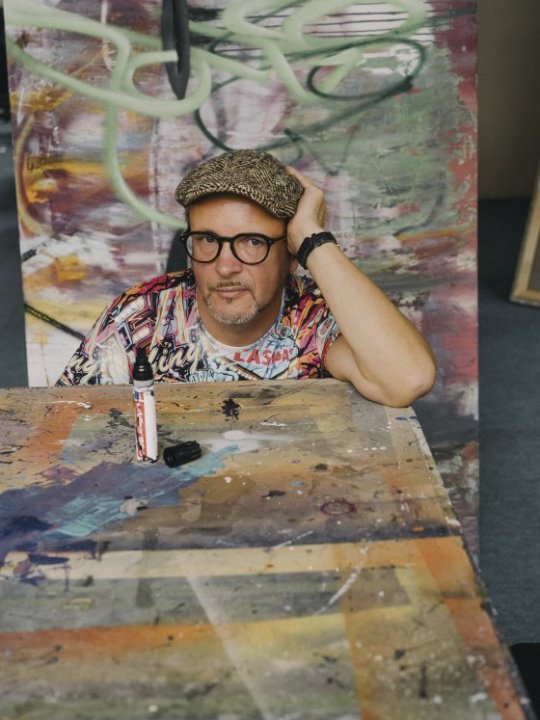
Nanna Heitmann—Magnum Photos for TIMETasso with an Edding marker pen like the one he bought in 1989.
Jens Müller, a.k.a. graffiti artist Tasso, owns many black Edding 850 marker pens today, but he is pretty sure that jumbled somewhere among them in his warehouse studio in Meerane is the one that changed his life. “For me it was the first time I had seen graffiti tags, on every corner in every place,” he says, of driving with friends around Kreuzberg in West Berlin as a 23-year-old. “I was wondering, ‘How have they done this?’ And then I see it must be a pen, a marker, and so I said, ‘I want to have this marker.’” He found one in a Karstadt department store that cost 10 of his 100 DM. “That was a lot. My friends thought I was crazy.” He worked in construction following reunification, eventually becoming a freelance artist. Today his tag is recognized around the world. He has visited 32 different countries to make, exhibit and promote his work.
Reading Material for the Runway
On a gray day in November 1988, 23-year-old fashion model and designer Grit Seymour was given four hours to leave the G.D.R. Her exit-visa application had been unexpectedly approved. “I had to speed pack,” she says. “My mother walked me to say goodbye. Of course we shed a lot of tears.” She stepped penniless into West Berlin, but remembers feeling instantly liberated. “It was like this huge block of concrete had fallen off my body.” With her Begrüßungsgeld she bought a copy of fashion magazine Vogue Italia, a window into a glamorous new world. On the night the Wall fell, Seymour was already modeling for Gianni Versace in Milan. She returned as fast as she could to Berlin to be reunited with family and friends. “It was like a dream coming true,” she says.
A Bouquet of Flowers for Grandma
“It set me free,” says Peter Keup, of how ballroom dancing made him feel while growing up in Dresden. He excelled at it competitively in partnership with his sister Uta, and in 1981 they were offered the chance to represent the G.D.R. internationally—but only if their family first withdrew a long-standing exit-visa application. They refused. “That’s when I took the decision to escape,” he says. In 1981, aged just 19, Keup set out for Czechoslovakia with a plan to swim across the River Danube from Hungary into Austria. He had 80 DM from his grandparents hidden in the seam of his jeans, which he hoped would pay his way to freedom. Instead he was caught on a train to Bratislava, arrested for currency smuggling and returned to the G.D.R. After a confession extracted under brutal interrogation, he was jailed by the Stasi for 10 months, spending long periods in solitary confinement. Keup’s grandparents’ lawyer helped convince the West German government to pay a $55,000 ransom, and suddenly he really was free. “For the first time it made me feel like an independent human being,” he says, of receiving his Begrüßungsgeld. The yellows and violets of the bouquet of freesia flowers he bought for his grandmother Anna remain bright in his mind. Keup boarded a train for the West German city of Essen and a new life. Years later, the Wall fell, and he and his sister danced together again.
Nothing: “I Was Not a Beggar”
Bernd Roth, a former major in the feared Stasi, is adamant he never claimed his Begrüßungsgeld. “I was not a beggar,” he says. Today Roth, 68, rejects the system that he served, yet is unapologetic about his own actions, which led to the known arrests of 14 people, including a CIA spy. “Why should we be pressured to have a bad [conscience]?” he asks. “We didn’t build concentration camps.” His love of music helped him preserve his individuality, he says. He thought nothing of singing along to “Born in the U.S.A.” at a Bruce Springsteen concert in East Berlin in 1988. “It was just music!” he laughs. Roth still lives in the same town in Thuringia where he grew up. The West has never held any appeal for him, he says. “I found it overwhelming and oppressive. I think oversaturated consumption is harmful.” Was there really nothing that he wanted there? “I might have bought myself some Grundig speakers,” he admits. “That was really just about being able to enjoy a better sound.”
Legos, a Radio and a Trip
Cornelia Guenther first entered the West at Berlin’s Checkpoint Charlie, the infamous Cold War crossing point. Then 29, and a single mother working as a translator, she gingerly stepped across the border in late-November 1989. “I looked at my foot,” she says, as she crossed the military checkpoint that she had overlooked every day from her office window. “I thought, ‘Now I’m walking on West Berlin soil; how amazing is this?’” Having collected their 200 DM, she and her son Christian, 6, bought carefully selected spoils at the KaDeWe: a backpack, some Legos, a radio for the kitchen. The rest of the cash they put toward a trip to England a few months later. “Buying experience was much more important to me than material things,” says Guenther.
A Computer, and a Future
When the Wall fell, Gordon van Godin was a 19-year-old newly discharged from national service in the East German army. He put his welcome money toward an Amiga computer so he could play Tetris and Formula 1 games. Today, he is director of Berlin’s DDR Museum of East German history, and qualified to bust some popular myths about Begrüßungsgeld. Is it true, for instance, that many people bought… bananas? “This is really a cliché, 100%,” he replies. “Because bananas we knew. We didn’t know, for example, kiwi fruit.” He believes the money helped establish a lasting hierarchy between West and East in a reunited Germany that still endures today. “I learned in school that in capitalism, nothing is for free,” Von Godin says. “You have to pay for everything sooner or later.”
via https://cutslicedanddiced.wordpress.com/2018/01/24/how-to-prevent-food-from-going-to-waste
0 notes
Text
Trabi
Trabi to pieszczotliwa nazwa Trabanta – NRD-owskiego samochodu, który był kiedyś bardzo popularny na naszych drogach. Dzisiaj jeden z nich u mnie na zdjęciu.
Trabant 601
Zdjęcie zostało celowo postarzone, aby wyglądało na fotografię z dawnych lat, W rzeczywistości zrobiłem je dwa lata temu w Krakowie.
View On WordPress
#Auto#Car#Cracow#Komuna#Kraków#M. ZUIKO DIGITAL#Moto#Motoryzacja#Olympus E-PL5#PRL#samochód#Trabant#Trabi
1 note
·
View note
Link
Již od pátku do neděle 19. ̶ 21. 7. 2019 se v plzeňském DEPO2015 zabydlí unikátní přehlídka historických i současných vozů s názvem „Skvosty s vůní benzínu“. Letos se pod tématem „Velké cesty“ kromě legendárních značek a sběratelských kousků objeví i zajímavé automobilové osobnosti. Mezi vystavenými vozy pak návštěvníci uvidí opravdové skvosty, z nichž některé nebyly ještě jinde vystaveny či jsou v ČR unikátem: prototyp LaFerrari, jediný Maserati MC 12 u nás anebo vozidlo afrického diktátora Imperial Le Baron.
Doprovodný program na cestovatelské scéně zahájí v pátek jeden z nejznámějších českých dobrodruhů současnosti Dan Přibáň, a to hned dvojím povídáním z cest a autogramiádou. V sobotu budou moci návštěvníci potkat dva mladé cestovatele a rodáky ze západočeských Plas Lukáše Sochu a Tomáše Vaňourka, kteří vloni absolvovali expedici nazvanou „Zikmund 100“. Při ní se vypravili po stopách Hanzelky a Zikmunda, za necelých deset měsíců zdolali 130.000 km, navštívili 32 zemí a zmapovali, jak se změnila místa, která slavná dvojice dokumentovala šedesát let před nimi. Výstava vybraných fotografií spolu s původními snímky bude k vidění po celou dobu akce. Zároveň se bude v sále Klempírny promítat krátký střihový film s dosud nezveřejněnými záběry z autentických cest Hanzelky a Zikmunda.
Dalším sobotním hostem je dobrodruh Tomáš Vejmola (známý jako blogger „Tomík na cestách“), který si v Bangkoku pořídil oblíbený taxikářský tuk-tuk a z Thajska se v něm za rok a den vrátil domů do Hranic na Moravě. Díky němu se návštěvníci povozí v Česku zřejmě jediném exemplář tohoto exotického vozítka.
V neděli se v „Dakar zóně“ představí úspěšný kamionový závodník Martin Macík Jr. a motorkář Jan Brabec. Macík vloni ve svých 28 letech dojel na 5. místě Dakarské rallye. Dakar bivak se závodním kamionem i motorkou a speciálně upravený doprovodný kamion i osobní automobil budou k vidění po celé tři dny akce.
Letošní novinkou jsou prezentace automobilových klubů, a to republikových i regionálních. V pátek se představí Rolls-Royce & Bentley Club ČR a Automotoklub Trabant Plzeň; v sobotu Jaguar klub spolu s VCC Domažlice a Corvette Clubem, v neděli Historic Club PAMK Klatovy.
Skvosty vzdají hold také plzeňskému podniku Metalex, zabývajícímu se převážně sportovními a závodními automobily a motocykly, který slaví 50. výročí založení. Zajímavá bude i retro expozice z dob socialismu s reprezentativními vozidly východního bloku.
Kdo se chce stát na skok celebritou, dostane možnost – každou hodinu se vylosuje výherce, který si vychutná posezení v luxusní limuzíně Lincoln TOP luxus 2019. Další zážitkové jízdy si můžou zájemci zakoupit, a to v BMW 326 cabrio z roku 1938, nebo v BMW Z3 roadster z roku 1997, známém z bondovky Zlaté oko/GoldenEye. Na mladší závodníky čekají šlapací motokáry a ti nejlepší se v sobotu odpoledne utkají v závodu o novou šlapací káru.
Skvosty s vůní benzínu se každoročně pojí také s uměním. Již tradičně zde své sochy umístí umělec Michal Gabriel – letos v podobě pěti obrovských žraloků. V Bistro&Café DEPO2015 bude zahájena výstava obrazů plzeňské malířky Doris Tesárkové Oplové, která vytvoří pro tuto příležitost zcela novou tématickou sérii obrazů. Po celé tři dny akci provází také hudební program, street food občerstvení a další zábava pro celou rodinu.
Vstupenky na místě stojí 250 Kč pro dospělé, 200 Kč zlevněné a 600 Kč rodinné vstupné. Nárok na slevu mají ve všech případech studenti, senioři a děti nad 130 cm. Menší děti a osoby s průkazkou ZTP a ZTP/P s doprovodem mohou na akci zdarma. Otevírací doba je v pátek 14°° – 20°°, v sobotu 10°° – 20°° a v neděli 10°° – 17°°.
Výběr z vystavených skvostů:
Ferrari F150 (La Ferrari) Proto MP2 – prototyp, který dosud nebyl nikde k vidění
Ferrari 599 GTB 60F1 Ferrari 150° Italia – vyrobeno pouze 40 kusů na světě
Maserati MC 12, jichž bylo vyrobeno pouhých 50 a z nich pouze jediný jezdí v Česku
supersporty Lamborghini Huracán, Lamborghini Aventador, Lamborgini Urus
Imperial Le Baron – původním majitelem byl gabonský diktátor Omar Bongo, který s ním navštívil všechny francouzské prezidenty od roku 1968
Porsche 911 Carrera 2 Cabrio – jedno z posledních 315 vyrobených vozů cabrio v roce 1994, kdy byla definitivně ukončena výroba
luxusní britský motocykl Brough Superior SS 100 TITANIUM – „Rolls-Royce“ mezi motorkami
Bentley Mulsanne Speed, Bentley Continental GT Convertible
McLaren 570S Coupe z kolekce Sports Series
elektrický Jaguar I-Pace – vyhrál Světové i Evropské auto roku 2019
Tatra 87, slavný československý automobil reprezentující předválečný vrchol nabídky aerodynamických designových modelů.
(adsbygoogle = window.adsbygoogle || []).push({});
Doprovodný program:
Povídání s Danem Přibáněm: pátek – 15:30 a 18:00, autogramiáda v 16:30.
Cestovatelé Tomáš Vaňourek a Lukáš Socha (Expedice Zikmund 100): sobota 13:00 a 17:30, autogramiáda ve 14:00.
Tomík na cestách – v tuktuku z Bangkoku až domů: sobota – 15:00, autogramiáda v 16:00. V tuktuku se budete moci projet každý den!
O Dakaru, autech, motorkách a Karlovi: neděle – 11:00 a 14:30. Autogramiáda Martina Macíka Jr. v 15:30.
BESIP TEAM: sobota – simulátor nárazu, řízení automobilu či motorky “pod vlivem” se speciálními brýlemi.
Projížďky po Plzni historickým autobusem: délka jízdy cca 20 min, odjezdy každé 2h
Příspěvek V Plzni se koná výstava ‘Skvosty s vůní benzínu’. Ukazuje unikátní supersporty i veterány [fotogalerie] pochází z auto-mania.cz
0 notes
Photo
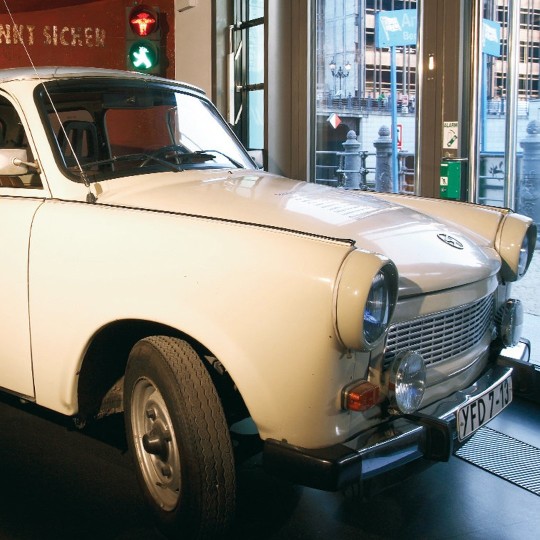
🇩🇪 Die Geschichte des Trabants begann am 14. Januar 1954, als im Ministerrat der DDR der Beschluss erging, einen neuen Kleinwagen aus volkseigener Produktion zu entwickeln. Vier Jahre später erschien der Personenwagen »P 50« – der Vorläufer des Trabants. Der Trabant P601, wie ihr ihn hier in unserer Ausstellung seht, ist der bekannteste und am längsten produzierte Trabant und lief von 1964 bis zum 25.07.1990 von den Bändern des VEB Sachsenring Automobilwerke Zwickau. 🇬🇧 The history of the Trabant began on 14 January 1954 when the GDR Council of Ministers passed a resolution to develop a new small car from national production. Four years later, the »P 50« passenger car appeared - the forerunner of the Trabant. The Trabant P601, as you see it here in our exhibition, is the best-known and longest-produced Trabant and rolled off the production lines of the VEB Sachsenring Automobilwerke Zwickau from 1964 to 25 July 1990. #ddrmuseum #ddrgram #instamuseum #ddr #gdr #museum #berlin #history #geschichte #trabant #p601 #trabi #oldtimer #vintagecars #museumfromhome — view on Instagram https://ift.tt/2Lytwib
22 notes
·
View notes
Photo

Der Trabant P50 oder auch Trabant 500 ist der erste Typ der Trabant-Modellreihe von Sachsenring aus Zwickau. Bis August 1958 trugen die Modelle noch die Bezeichnung AWZ P50 „Trabant“. Vom Typ P50 wurden zwischen 1958 und 1962 insgesamt 131.450 Wagen gebaut, inklusive 50 Nullserienwagen im November 1957. Der Motor wurde im Barkas-Werk produziert. Die Bezeichnung P50 bedeutet Personenkraftwagen mit 500 cm³ Hubraum. Der Trabant P50 war einer der ersten vollwertigen Kleinwagen mit Frontantrieb und entsprach dem damaligen Trend bei der Entwicklung von Automobilen zur Massenmotorisierung. . Am häufigsten war der Trabant 500 als Limousine in Standardausführung, von der 81.710 Stück gebaut wurden. Ab 1959 gab es Fahrzeuge in Sonderausführung mit geschwungener Chromzierleiste und Zweifarblackierung, anfangs gab es sogar eine dreifarbige Sonderwunsch-Variante. Merkmale der Sonderausführung waren eine andere Polsterung der Sitze, Sonnenblenden, Ascher im Fondraum, sowie Beleuchtung im Motor- und Kofferraum. Ab 1961 war die Sonderausführung mit einer gerade verlaufenden Zierleiste und Zweifarblackierung versehen. Von den Varianten Sonderausführung und Sonderwunsch wurden insgesamt 38.097 Fahrzeuge produziert. . 1958 wurde eine Nullserie des Trabant Kombi gefertigt, dessen Serienproduktion dann 1959 begann. Die Kombies wurden mit einer anderen Achsübersetzung von 4,94 ausgeliefert, was eine im Vergleich zur Limousine geringere Höchstgeschwindigkeit von 90 km/h ergab. 1961 wurde eine Lieferwagen-Variante präsentiert, die jedoch erst als P60 in geringer Stückzahl produziert wurde. Insgesamt wurden 11.643 Kombis des Trabant 500 hergestellt. (via #Wikipedia) . #Trabant #Trabant500 #TrabantP50 #Limousine #VEB #Sachsenring #Automobilwerke #Zwickau #DDR #GDR #Reklame #Ostalgie #EastGermany https://www.instagram.com/p/B9Hmw2JiRCb/?igshid=g62qmok3j8vp
#wikipedia#trabant#trabant500#trabantp50#limousine#veb#sachsenring#automobilwerke#zwickau#ddr#gdr#reklame#ostalgie#eastgermany
14 notes
·
View notes
Photo

Der Trabant P50 oder auch Trabant 500 ist der erste Typ der Trabant-Modellreihe von Sachsenring aus Zwickau. Bis August 1958 trugen die Modelle noch die Bezeichnung AWZ P50 „Trabant“. Vom Typ P50 wurden zwischen 1958 und 1962 insgesamt 131.450 Wagen gebaut, inklusive 50 Nullserienwagen im November 1957. Der Motor wurde im Barkas-Werk produziert. Die Bezeichnung P50 bedeutet Personenkraftwagen mit 500 cm³ Hubraum. Der Trabant P50 war einer der ersten vollwertigen Kleinwagen mit Frontantrieb und entsprach dem damaligen Trend bei der Entwicklung von Automobilen zur Massenmotorisierung. . Am häufigsten war der Trabant 500 als Limousine in Standardausführung, von der 81.710 Stück gebaut wurden. Ab 1959 gab es Fahrzeuge in Sonderausführung mit geschwungener Chromzierleiste und Zweifarblackierung, anfangs gab es sogar eine dreifarbige Sonderwunsch-Variante. Merkmale der Sonderausführung waren eine andere Polsterung der Sitze, Sonnenblenden, Ascher im Fondraum, sowie Beleuchtung im Motor- und Kofferraum. Ab 1961 war die Sonderausführung mit einer gerade verlaufenden Zierleiste und Zweifarblackierung versehen. Von den Varianten Sonderausführung und Sonderwunsch wurden insgesamt 38.097 Fahrzeuge produziert. . 1958 wurde eine Nullserie des Trabant Kombi gefertigt, dessen Serienproduktion dann 1959 begann. Die Kombies wurden mit einer anderen Achsübersetzung von 4,94 ausgeliefert, was eine im Vergleich zur Limousine geringere Höchstgeschwindigkeit von 90 km/h ergab. 1961 wurde eine Lieferwagen-Variante präsentiert, die jedoch erst als P60 in geringer Stückzahl produziert wurde. Insgesamt wurden 11.643 Kombis des Trabant 500 hergestellt. (via #Wikipedia) . #Trabant #Trabant500 #TrabantP50 #Kombi #Limousine #VEB #Sachsenring #Automobilwerke #Zwickau #DDR #GDR #Reklame #Ostalgie #EastGermany https://www.instagram.com/p/BvuCQBLh0OS/?igshid=lt5y9dy2ga7i
#wikipedia#trabant#trabant500#trabantp50#kombi#limousine#veb#sachsenring#automobilwerke#zwickau#ddr#gdr#reklame#ostalgie#eastgermany
7 notes
·
View notes
Photo

Der Trabant P50 oder auch Trabant 500 ist der erste Typ der Trabant-Modellreihe von Sachsenring aus Zwickau. Bis August 1958 trugen die Modelle noch die Bezeichnung AWZ P50 „Trabant“. Vom Typ P50 wurden zwischen 1958 und 1962 insgesamt 131.450 Wagen gebaut, inklusive 50 Nullserienwagen im November 1957. Der Motor wurde im Barkas-Werk produziert. Die Bezeichnung P50 bedeutet Personenkraftwagen mit 500 cm³ Hubraum. Der Trabant P50 war einer der ersten vollwertigen Kleinwagen mit Frontantrieb und entsprach dem damaligen Trend bei der Entwicklung von Automobilen zur Massenmotorisierung. . Am häufigsten war der Trabant 500 als Limousine in Standardausführung, von der 81.710 Stück gebaut wurden. Ab 1959 gab es Fahrzeuge in Sonderausführung mit geschwungener Chromzierleiste und Zweifarblackierung, anfangs gab es sogar eine dreifarbige Sonderwunsch-Variante. Merkmale der Sonderausführung waren eine andere Polsterung der Sitze, Sonnenblenden, Ascher im Fondraum, sowie Beleuchtung im Motor- und Kofferraum. Ab 1961 war die Sonderausführung mit einer gerade verlaufenden Zierleiste und Zweifarblackierung versehen. Von den Varianten Sonderausführung und Sonderwunsch wurden insgesamt 38.097 Fahrzeuge produziert. . 1958 wurde eine Nullserie des Trabant Kombi gefertigt, dessen Serienproduktion dann 1959 begann. Die Kombies wurden mit einer anderen Achsübersetzung von 4,94 ausgeliefert, was eine im Vergleich zur Limousine geringere Höchstgeschwindigkeit von 90 km/h ergab. 1961 wurde eine Lieferwagen-Variante präsentiert, die jedoch erst als P60 in geringer Stückzahl produziert wurde. Insgesamt wurden 11.643 Kombis des Trabant 500 hergestellt. (via #Wikipedia) . #Trabant #Trabant500 #TrabantP50 #Kombi #Limousine #VEB #Sachsenring #Automobilwerke #Zwickau #DDR #GDR #Reklame #Ostalgie #EastGermany https://www.instagram.com/p/BvuCQBLh0OS/?igshid=1dslj7o3xx3a3
#wikipedia#trabant#trabant500#trabantp50#kombi#limousine#veb#sachsenring#automobilwerke#zwickau#ddr#gdr#reklame#ostalgie#eastgermany
19 notes
·
View notes
Photo

Der Trabant P50 oder auch Trabant 500 ist der erste Typ der Trabant-Modellreihe von Sachsenring aus Zwickau. Bis August 1958 trugen die Modelle noch die Bezeichnung AWZ P50 „Trabant“. Vom Typ P50 wurden zwischen 1958 und 1962 insgesamt 131.450 Wagen gebaut, inklusive 50 Nullserienwagen im November 1957. Der Motor wurde im Barkas-Werk produziert. Die Bezeichnung P50 bedeutet Personenkraftwagen mit 500 cm³ Hubraum. Der Trabant P50 war einer der ersten vollwertigen Kleinwagen mit Frontantrieb und entsprach dem damaligen Trend bei der Entwicklung von Automobilen zur Massenmotorisierung. . Am häufigsten war der Trabant 500 als Limousine in Standardausführung, von der 81.710 Stück gebaut wurden. Ab 1959 gab es Fahrzeuge in Sonderausführung mit geschwungener Chromzierleiste und Zweifarblackierung, anfangs gab es sogar eine dreifarbige Sonderwunsch-Variante. Merkmale der Sonderausführung waren eine andere Polsterung der Sitze, Sonnenblenden, Ascher im Fondraum, sowie Beleuchtung im Motor- und Kofferraum. Ab 1961 war die Sonderausführung mit einer gerade verlaufenden Zierleiste und Zweifarblackierung versehen. Von den Varianten Sonderausführung und Sonderwunsch wurden insgesamt 38.097 Fahrzeuge produziert. . 1958 wurde eine Nullserie des Trabant Kombi gefertigt, dessen Serienproduktion dann 1959 begann. Die Kombies wurden mit einer anderen Achsübersetzung von 4,94 ausgeliefert, was eine im Vergleich zur Limousine geringere Höchstgeschwindigkeit von 90 km/h ergab. 1961 wurde eine Lieferwagen-Variante präsentiert, die jedoch erst als P60 in geringer Stückzahl produziert wurde. Insgesamt wurden 11.643 Kombis des Trabant 500 hergestellt. (via #Wikipedia) _____________________ #Trabant #Trabant500 #TrabantP50 #Limousine #VEB #Sachsenring #Automobilwerke #Zwickau #DDR #GDR #Reklame #Ostalgie #EastGermany https://www.instagram.com/p/BzGP0RoCjqN/?igshid=8itc6zu1jfk6
#wikipedia#trabant#trabant500#trabantp50#limousine#veb#sachsenring#automobilwerke#zwickau#ddr#gdr#reklame#ostalgie#eastgermany
5 notes
·
View notes
Photo

Der Trabant P50 oder auch Trabant 500 ist der erste Typ der Trabant-Modellreihe von Sachsenring aus Zwickau. Bis August 1958 trugen die Modelle noch die Bezeichnung AWZ P50 „Trabant“. Vom Typ P50 wurden zwischen 1958 und 1962 insgesamt 131.450 Wagen gebaut, inklusive 50 Nullserienwagen im November 1957. Der Motor wurde im Barkas-Werk produziert. Die Bezeichnung P50 bedeutet Personenkraftwagen mit 500 cm³ Hubraum. Der Trabant P50 war einer der ersten vollwertigen Kleinwagen mit Frontantrieb und entsprach dem damaligen Trend bei der Entwicklung von Automobilen zur Massenmotorisierung. . Am häufigsten war der Trabant 500 als Limousine in Standardausführung, von der 81.710 Stück gebaut wurden. Ab 1959 gab es Fahrzeuge in Sonderausführung mit geschwungener Chromzierleiste und Zweifarblackierung, anfangs gab es sogar eine dreifarbige Sonderwunsch-Variante. Merkmale der Sonderausführung waren eine andere Polsterung der Sitze, Sonnenblenden, Ascher im Fondraum, sowie Beleuchtung im Motor- und Kofferraum. Ab 1961 war die Sonderausführung mit einer gerade verlaufenden Zierleiste und Zweifarblackierung versehen. Von den Varianten Sonderausführung und Sonderwunsch wurden insgesamt 38.097 Fahrzeuge produziert. . 1958 wurde eine Nullserie des Trabant Kombi gefertigt, dessen Serienproduktion dann 1959 begann. Die Kombies wurden mit einer anderen Achsübersetzung von 4,94 ausgeliefert, was eine im Vergleich zur Limousine geringere Höchstgeschwindigkeit von 90 km/h ergab. 1961 wurde eine Lieferwagen-Variante präsentiert, die jedoch erst als P60 in geringer Stückzahl produziert wurde. Insgesamt wurden 11.643 Kombis des Trabant 500 hergestellt. (via #Wikipedia) . #Trabant #Trabant500 #TrabantP50 #Kombi #Limousine #VEB #Sachsenring #Automobilwerke #Zwickau #DDR #GDR #Reklame #Ostalgie #EastGermany https://www.instagram.com/p/BvuCQBLh0OS/?utm_source=ig_tumblr_share&igshid=16kol5tn9rfvl
#wikipedia#trabant#trabant500#trabantp50#kombi#limousine#veb#sachsenring#automobilwerke#zwickau#ddr#gdr#reklame#ostalgie#eastgermany
7 notes
·
View notes
Photo
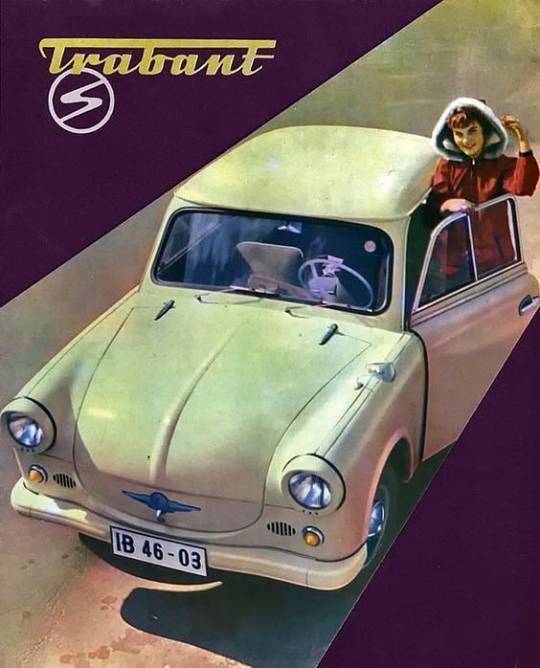
Der Trabant P50 oder auch Trabant 500 ist der erste Typ der Trabant-Modellreihe von Sachsenring aus Zwickau. Bis August 1958 trugen die Modelle noch die Bezeichnung AWZ P50 „Trabant“. Vom Typ P50 wurden zwischen 1958 und 1962 insgesamt 131.450 Wagen gebaut, inklusive 50 Nullserienwagen im November 1957. Der Motor wurde im Barkas-Werk produziert. Die Bezeichnung P50 bedeutet Personenkraftwagen mit 500 cm³ Hubraum. Der Trabant P50 war einer der ersten vollwertigen Kleinwagen mit Frontantrieb und entsprach dem damaligen Trend bei der Entwicklung von Automobilen zur Massenmotorisierung. . Am häufigsten war der Trabant 500 als Limousine in Standardausführung, von der 81.710 Stück gebaut wurden. Ab 1959 gab es Fahrzeuge in Sonderausführung mit geschwungener Chromzierleiste und Zweifarblackierung, anfangs gab es sogar eine dreifarbige Sonderwunsch-Variante. Merkmale der Sonderausführung waren eine andere Polsterung der Sitze, Sonnenblenden, Ascher im Fondraum, sowie Beleuchtung im Motor- und Kofferraum. Ab 1961 war die Sonderausführung mit einer gerade verlaufenden Zierleiste und Zweifarblackierung versehen. Von den Varianten Sonderausführung und Sonderwunsch wurden insgesamt 38.097 Fahrzeuge produziert. . 1958 wurde eine Nullserie des Trabant Kombi gefertigt, dessen Serienproduktion dann 1959 begann. Die Kombies wurden mit einer anderen Achsübersetzung von 4,94 ausgeliefert, was eine im Vergleich zur Limousine geringere Höchstgeschwindigkeit von 90 km/h ergab. 1961 wurde eine Lieferwagen-Variante präsentiert, die jedoch erst als P60 in geringer Stückzahl produziert wurde. Insgesamt wurden 11.643 Kombis des Trabant 500 hergestellt. (via #Wikipedia) _____________________ #Trabant #Trabant500 #TrabantP50 #Kombi #Limousine #VEB #Sachsenring #Automobilwerke #Zwickau #DDR #GDR #Reklame #Ostalgie #EastGermany #Vintage #Vintagead https://www.instagram.com/p/BrIj-AkBY2U/?utm_source=ig_tumblr_share&igshid=1rnr6sopb6af0
#wikipedia#trabant#trabant500#trabantp50#kombi#limousine#veb#sachsenring#automobilwerke#zwickau#ddr#gdr#reklame#ostalgie#eastgermany#vintage#vintagead
16 notes
·
View notes